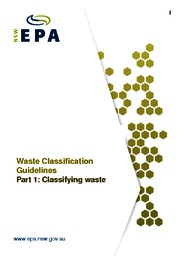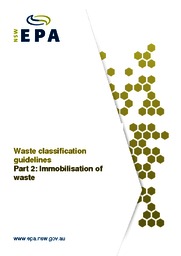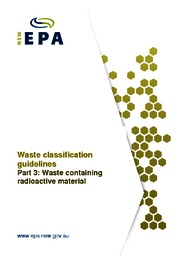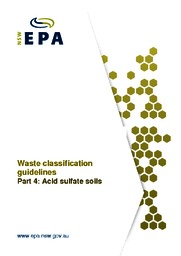The waste classes are based on the level of risk they pose to the environment and human health. They are
- special waste
- liquid waste
- hazardous waste
- restricted solid waste
- general solid waste (putrescible)
- general solid waste (non-putrescible)
Classifying wastes into groups that pose similar risks to the environment and human health facilitates their management and appropriate disposal.
To help waste generators classify the wastes they produce, the NSW Environment Protection Authority (EPA) has developed Waste Classification Guidelines which are a step-by-step process for classifying waste.
Generators and waste facilities must ensure they classify their waste carefully in accordance with the procedures in the guidelines. This is because waste can only be taken to, and accepted at, a waste facility which is lawfully authorised to receive, re-use and/or dispose of that classification or type of waste.
The Waste Classification Guidelines comprise four parts:
- Part 1: Classifying waste (PDF 599KB)
- Part 2: Immobilising waste (PDF 310KB)
- Part 3: Waste containing radioactive material (PDF 296KB)
- Part 4: Acid sulfate soils (PDF 299KB)
Addendum to Part 1: classifying waste to include PFAS
The EPA has issued an Addendum to the Waste Classification Guidelines (2014) – Part 1: classifying waste in response to the classification of per- and poly- fluoroalkyl substances (PFAS) as emerging contaminants. The addendum contains interim test values developed by the EPA for specific contaminant concentration (SCC) and leachable concentration using the toxicity characteristics leaching procedure (TCLP) for the most common PFAS compounds. These include perfluoro-octane sulfonic acid (PFOS), perfluoro-octanoic acid (PFOA), and perfluoro-hexane sulfonate (PFHxS).
Generators of waste that contains, or may potentially contain, PFAS must ensure they undertake chemical assessment consistent with step 5 of Part 1 of the Waste Classification Guidelines for PFOS, PFHxS, and PFOA and in accordance with the addendum.
Classification report
When writing a waste classification report, the following must be included
- the full name, address, Australian Company Number (ACN) or Australian Business Number (ABN) of the organisation and person(s) providing the waste classification
- location of the site where the waste was generated, including the site address
- history of the material and the processes and activities that have taken place to produce the waste
- potential contaminating activities that may have occurred at the site where the waste was generated
- description of the waste, including photographs, visible signs of contamination, such as discolouration, staining, odours, etc.
- quantity of the waste
- number of samples collected and analysed
- sampling method including pattern, depth, locations, sampling devices, procedures, and photos of the sample locations and samples
- contaminants tested
- laboratory documentation – chain-of-custody, sample receipt, laboratory report
- all results regardless of whether they are not used in the classification process
- results of sample mean, sample standard deviation and the 95 per cent upper confidence limit (UCL)
- brief summary of findings including discussion of results, exceedances of the relevant contaminant threshold (CT) or specific contaminant concentration (SCC) and toxicity characteristics leaching procedure (TCLP) threshold values
- a clear statement of the classification of the waste as at the time of the report
What to do once a waste has been classified
Once a waste has been classified in accordance with the EPA Waste Classification Guidelines, it can be managed appropriately as required under the Protection of the Environment Operations Act 1997 (POEO Act) and its associated regulations.
Taking waste to the right waste facility
If the waste will be taken to another site, the EPA strongly recommends the following steps to ensure the waste is taken to a facility that can lawfully receive it:
- Check the POEO public register to determine whether the waste facility is licensed by the EPA.
- If the waste facility is licensed by the EPA, check the facility's environment protection licence and determine whether it can lawfully receive your waste. Even though a waste facility may be licensed by the EPA, this does not necessarily mean it can lawfully receive the class of waste that you have classified.
- If the waste facility is not licensed by the EPA, the EPA recommends you check the facility has consent from the local council to receive that class of waste and undertake its waste activities.
Managing specific types of waste – further requirements
- Waste tracking is a requirement for some types of waste. Once you have determined the class of the waste, you then need to determine whether the waste must be tracked.
- Some wastes have specialised storage, handling, treatment and disposal requirements. See Types of waste for further guidance on managing specific wastes.
- Some chemicals and chemical wastes are covered by a chemical control order (CCO). Anyone dealing with a chemical or chemical waste that is covered by a CCO must comply with the CCO requirements. CCOs are a primary regulatory tool under the Environmentally Hazardous Chemicals Act 1985 and are used by the EPA to selectively and specifically control particular chemicals of concern, and limit their potential or actual impact on the environment.





